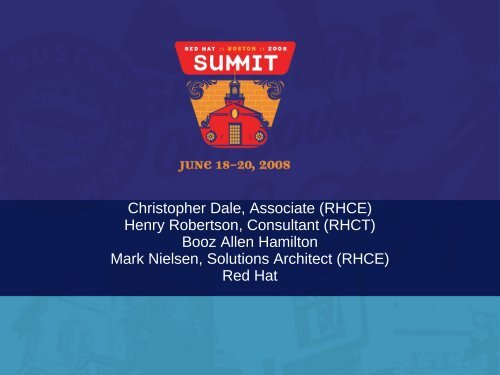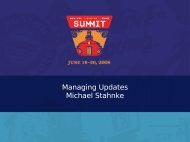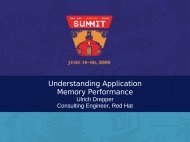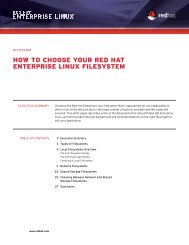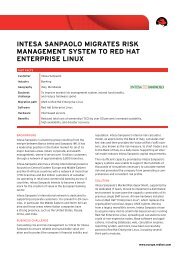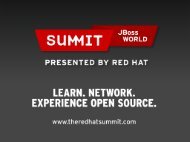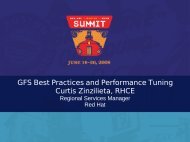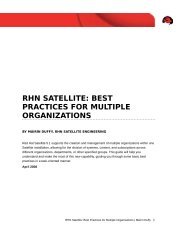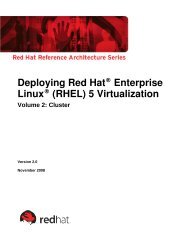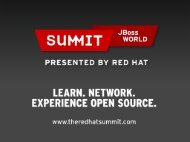Christopher Dale, Associate (RHCE) Henry Robertson ... - Red Hat
Christopher Dale, Associate (RHCE) Henry Robertson ... - Red Hat
Christopher Dale, Associate (RHCE) Henry Robertson ... - Red Hat
Create successful ePaper yourself
Turn your PDF publications into a flip-book with our unique Google optimized e-Paper software.
<strong>Christopher</strong> <strong>Dale</strong>, <strong>Associate</strong> (<strong>RHCE</strong>)<br />
<strong>Henry</strong> <strong>Robertson</strong>, Consultant (RHCT)<br />
Booz Allen Hamilton<br />
Mark Nielsen, Solutions Architect (<strong>RHCE</strong>)<br />
<strong>Red</strong> <strong>Hat</strong>
Grid Enabled Services Infrastructure<br />
Enabling the 'Cloud' in the Dynamic Data Center
Agenda<br />
Overview<br />
Process<br />
Implementation<br />
Service Grid<br />
Hardware<br />
Networking Concerns<br />
Storage<br />
Building Xen Machines
Agenda<br />
Overview<br />
Process<br />
Implementation<br />
Service Grid<br />
Hardware<br />
Networking Concerns<br />
Storage<br />
Building Xen Machines
Overview<br />
History of the Data Center<br />
Challenges<br />
Requirements<br />
Tomorrow's History
History of the Data Center<br />
Virtual Infrastructure<br />
Hardware + Virtual Infrastructure<br />
Software<br />
Data Center<br />
Physical space, power and<br />
cooling<br />
Systems<br />
Virtual Machines<br />
Capabilities developed in more efficient<br />
virtual space, but developed with a traditional<br />
mind set<br />
Hardware, software, etc.
Challenges<br />
Satisfying high availability and agility requirements<br />
Meet Disaster Recovery Objectives<br />
Unpredictable mission growth<br />
Exponentially increasing data and rapidly growing user base<br />
Need to efficiently manage resources within flat IT budgets<br />
Integrating improved technology solutions<br />
Approaching size, weight and power (SWaP) limitations<br />
Costs increasing with user expectations and maintenance<br />
needs
Requirements for a community cloud<br />
Accredited Platform<br />
Scalable (Elastic)<br />
● Vertical<br />
● Horizontal<br />
More Efficient<br />
● Power<br />
● Cooling<br />
● Floor Space<br />
More Effective<br />
● New Service Delivery<br />
● Leveraging existing<br />
capabilities and<br />
knowledge<br />
Agile<br />
● Infrastructure<br />
● Software Development<br />
Cost Effective<br />
Maintainable<br />
● Highly available<br />
● Continual refresh<br />
● Hardware independent<br />
● <strong>Red</strong>undant<br />
Establish SLO/SLA<br />
(Active...Deployable)<br />
● Availability<br />
● Scalability<br />
● Performance
Tomorrow's History<br />
Grid Enabled Services Platform<br />
Data Center design and planning (floor space, power and cooling),<br />
Hardware, Software, grid storage container, clustered applications<br />
server, integrated data source abstraction, grid database container,<br />
Directory Server and other capabilities as they are developed and<br />
integrated<br />
Virtual Infrastructure<br />
Hardware + Virtual Infrastructure<br />
Software<br />
Data Center<br />
Physical space, power and<br />
cooling<br />
Systems<br />
Virtual Machines<br />
Capabilities developed in more efficient<br />
virtual space, but developed with a traditional<br />
mind set<br />
Hardware, software, etc.<br />
Services<br />
Services Delta
Agenda<br />
Overview<br />
Process<br />
Implementation<br />
Service Grid<br />
Hardware<br />
Networking Concerns<br />
Storage<br />
Building Xen Machines
System Engineering and Integration Process
Process Disciplines<br />
Capacity Modeling – Identify and model physical constraints and<br />
generate resource overlay for environment<br />
Mission Engineering – Perform Community Analysis, Operations<br />
Analysis and Systems Analysis to determine Operational<br />
Requirements<br />
Agile Systems Engineering – Identify or Design and Develop<br />
Mission Components according to requirements<br />
Platform Simulation – Model impact of change<br />
Platform Integration – Develop integration plan and evaluate<br />
simulation results<br />
Platform Management – Implementation of Service Level<br />
Agreements and execution of system changes
Agenda<br />
Overview<br />
Process<br />
Implementation<br />
Service Grid<br />
Hardware<br />
Networking Concerns<br />
Storage<br />
Building Xen Machines
Implementation<br />
The SOA environment favors:<br />
- reuse over reinventing<br />
- COTS/GOTS integration<br />
- new service exposure via VM<br />
- “sleep” until needed services<br />
Clustering of computers in a<br />
fixed configuration designed to<br />
be operated and managed as a<br />
unified, high-performance<br />
machine allowing reconfiguration<br />
of the grid in real time<br />
Agile Grid Framework to build<br />
a SOA, reconstruct the<br />
infrastructure and enable a<br />
scalable application host<br />
The physical resource pool for<br />
use at the virtual layer and<br />
above<br />
<strong>Red</strong> <strong>Hat</strong> Cluster Suite enables<br />
application failover for virtual<br />
servers, ensuring functionspecific<br />
support<br />
Commodity hardware<br />
components enable lower<br />
start-up, maintenance and<br />
upgrade costs<br />
Virtualization of server,<br />
network and storage<br />
improves hardware utilization<br />
Global File System (GFS) on<br />
top of clustered logical<br />
volumes (clvm) enable virtual<br />
storage<br />
Bonded interface adapters<br />
with tagged Virtual Lans<br />
enable virtual networking<br />
XEN enables multiple, transient, function-specific virtual<br />
servers to deploy services, with low instantiation costs, by<br />
migrating setup and configuration of each Operating System<br />
to open source software
Agenda<br />
Overview<br />
Process<br />
Implementation<br />
Service Grid<br />
Hardware<br />
Networking Concerns<br />
Storage<br />
Building Xen Machines
Service Grid
Agenda<br />
Overview<br />
Process<br />
Implementation<br />
Service Grid<br />
Hardware<br />
Networking Concerns<br />
Storage<br />
Building Xen Machines
Hardware Configuration<br />
Cisco 6509<br />
with FSM<br />
Dell 2950 Brocade 48000<br />
Fibre Channel<br />
Director<br />
Cluster Communications<br />
Bonded, VLANed Fiber<br />
Fibre Channel<br />
3Par S400
Agenda<br />
Overview<br />
Process<br />
Implementation<br />
Service Grid<br />
Hardware<br />
Networking Concerns<br />
Storage<br />
Building Xen Machines
Networking Concerns<br />
Xen Bridging<br />
Configured to utilize 802.1q VLAN tagging. Bonded interfaces are connected<br />
to trunk ports on the switch. Xen bridging is configured to tag packets to match<br />
VLAN configuration on the network<br />
NIC Bonding<br />
Link Aggregation Control Protocol (LACP)<br />
The networking device manages aggregation. An etherchannel bundle must<br />
be configured on the switch.<br />
Cluster Communication<br />
IGMP is utilized to manage the cluster. Close attention to multicasting traffic is<br />
required<br />
IGMP configuration is required on Cisco switches<br />
Cisco Pix, ASA and FWSM utilize security levels to manage multicast<br />
traffic.<br />
ACL's can be utilized to manage outbound multicast traffic<br />
Fencing<br />
Fencing operations multicast a fence request. It is important to manage<br />
access to participating VLAN's. With Cisco firewalls this is accomplished<br />
through security levels of firewall interfaces.
Agenda<br />
Overview<br />
Process<br />
Implementation<br />
Service Grid<br />
Hardware<br />
Networking Concerns<br />
Storage<br />
Building Xen Machines
Storage<br />
SAN Considerations<br />
● Fabric Design<br />
● Thin Provisioning (SAN vs Host)<br />
Host<br />
● Clvmd<br />
● GFS<br />
● /dev/VolGrp01/LV<br />
● /etc/xen<br />
Xen Machines<br />
● Clvmd<br />
● GFS<br />
● /jbossdeploy<br />
● /landingzone<br />
● /contentrepo
Agenda<br />
Overview<br />
Process<br />
Implementation<br />
Service Grid<br />
Hardware<br />
Networking Concerns<br />
Storage<br />
Building Xen Machines
Building a Xen Machine<br />
Virt-install<br />
● Media Respository<br />
● Kick Start<br />
● Attach to appropriate physical storage<br />
● Bridge to network segment that has deployment server<br />
● Post build<br />
● Reconfigure to /etc/xen<br />
● Add storage<br />
● Add bridges<br />
● Add to cluster
Benefits<br />
Improve performance, availability, and cost-effectiveness of<br />
compute and data intensive applications<br />
Run growing volume of complex, resource-intensive, highperformance<br />
computing jobs within existing distributed<br />
infrastructure<br />
Provision additional capacity dynamically as it becomes<br />
available, and failover gracefully around unavailable capacity,<br />
without interrupting jobs in progress<br />
<strong>Red</strong>uces total cost of ownership of ongoing information<br />
technology (IT) operations by making more efficient use of<br />
available computing , storage, and network capacity<br />
Postpone the need for deployment of additional capacity to<br />
support growing transaction loads<br />
Provision, scale, and reconfigure virtualized computing<br />
resources within a service-oriented environment
Questions?<br />
<strong>Christopher</strong> <strong>Dale</strong> <strong>Associate</strong><br />
dale_christopher@bah.com<br />
Isaac Christoffersen <strong>Associate</strong><br />
christoffersen_isaac@bah.com<br />
<strong>Henry</strong> <strong>Robertson</strong> Consultant<br />
robertson_henry@bah.com<br />
Mark Nielsen Solutions Architect<br />
mnielsen@redhat.com


